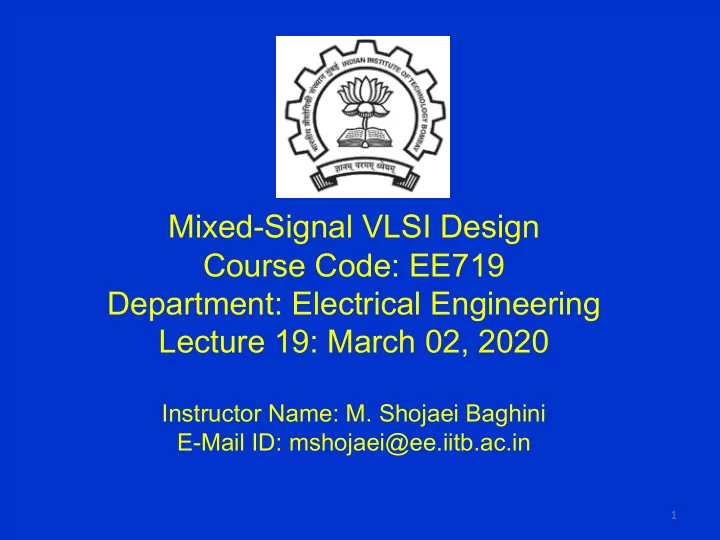

Mixed-Signal VLSI Design Course Code: EE719 Department: Electrical Engineering Lecture 19: March 02, 2020 Instructor Name: M. Shojaei Baghini E-Mail ID: mshojaei@ee.iitb.ac.in 1
2 2 Module 20 Introduction to Performance Parameters of Data Converters References • Understanding Data Converters, TI, 1995. • Chapter 5, the Data Conversion Handbook, Analog Devices, 2005. IIT-Bombay Lecture 19 M. Shojaei Baghini
3 3 Bridge Between Analog and Digital Domains A/D Conditioning Conversion Analog Digital Domain Domain Smoothing D/A and Conversion Equalization IIT-Bombay Lecture 19 M. Shojaei Baghini
4 4 Basic Metrics to Start with l Full Scale Range l Resolution: Effective Number of Bits (ENOB) l Introduced Noise and Distortion: Signal to Noise and Distortion Ratio l Signal Bandwidth l Sampling Frequency IIT-Bombay Lecture 19 M. Shojaei Baghini
5 5 Signal-to-Noise and Distortion Ratio (SNDR) Assume N-point FFT of a sine wave test. If the fundamental frequency is in bin m and has amplitude A m then SNDR is given by the following relation. IIT-Bombay Lecture 19 M. Shojaei Baghini
6 6 SFDR - Example Noise floor Source: Nicolas Gray, National Semiconductor, 2006 Note: The average value of the noise contained in each frequency bin of M-point FFT is 10 ´ log (M/2) dB below the total noise power. IIT-Bombay Lecture 19 M. Shojaei Baghini
7 7 Spurious-Free Dynamic Range (SFDR) l In general dynamic range is the ratio of largest absolute value of the signal to the smallest absolute value of the signal. l Spurious-free dynamic range (SFDR) is ratio of the input signal to the peak harmonic (or spurious) component. It’s a measure of signal/data fidelity. Example: fractions of f s in !" ADC IIT-Bombay Lecture 19 M. Shojaei Baghini
8 8 Intermodulation Distortion (IMD) l Most of signals contain many frequency components. l Non-linearity causes two or more signal frequencies to produce intermodulation products. Single tone SFDR Multi tone SFDR Source: Analog Devices tutorial MT-053, 2009 Frequency Frequency IIT-Bombay Lecture 19 M. Shojaei Baghini
9 9 Ideal Characteristics of DAC/ADC D : LSB size Starting from DAC =>? @ : ×2 : / 012_456 = ∆ 9 DAC (I) :;< Type equation here. b i : bit # i Center point Analog input range • 1 LSB May be [-V FS /2,V FS /2]. ADC (II) Signed output code • may be used. IIT-Bombay Lecture 19 M. Shojaei Baghini
10 10 Classification Based on Sampling Rate of Low-pass Signals • f s > 2 × BW (Nyquist rate sampling but not much higher than 2) – "Nyquist Converters“ – It requires high-performance anti-aliasing filtering. • fs >> 2 × BW Oversampling (Oversampled converters with noise shaping) – Simple anti-aliasing filter and smoothing filter is enough. – Oversampling reduces quantization noise. • fs < 2 × BW (Undersampling or sub-sampling) Useful for signals of which power is concentrated in a narrow band around a frequency. IIT-Bombay Lecture 19 M. Shojaei Baghini
11 11 Common Performance Measures Static Measures • Monotonicity • Offset • Full-scale gain error and gain error • Diff. nonlinearity (DNL) (mainly for Nyquist converters) • Integral nonlinearity (INL) (mainly for Nyquist converters) Dynamic Measures • Delay, settling time • Aperture uncertainty • Distortion- harmonic content • Signal-to-(noise and distortion) ratio (SNDR) • Idle channel noise • Spurious-free dynamic range (SFDR) IIT-Bombay Lecture 19 M. Shojaei Baghini
12 12 Static Specifications Offset Error (Zero Scale Error) Center point 1 LSB Offset error is the shift of the first transition point. Similar notion for full scale error • IIT-Bombay Lecture 19 M. Shojaei Baghini
13 13 Static Specifications – Simple Definition of Gain Error for DAC Gain error (in units of LSB) = V 111 / (V FS – 1 LSB) - 1 Is this the best definition? Source: The data conversion handbook, Analog Devices, 2005 IIT-Bombay Lecture 19 M. Shojaei Baghini
14 14 Static Specifications - Concept of Gain Connecting center of segments will not results in a line. Which definition does present the gain better? • IIT-Bombay Lecture 19 M. Shojaei Baghini
15 15 Static Specifications Differential Nonlinearity (DNL) of DAC Variation of Difference with the code results in nonlinearity: SQNR degradation Source: The data conversion handbook, Analog Devices, 2005 IIT-Bombay Lecture 19 M. Shojaei Baghini
16 16 Static Specifications Differential Nonlinearity (DNL) of ADC DNL min > -1 LSB (no missing code). Source: The data conversion handbook, Analog Devices, 2005 IIT-Bombay Lecture 19 M. Shojaei Baghini
17 17 Static Specifications: Integrated Nonlinearity (INL) of ADC and DAC Variation of transition points Understanding Data Converters, TI, 1995 IIT-Bombay Lecture 19 M. Shojaei Baghini
18 18 Static Specifications Integrated Nonlinearity (INL) of DAC After offset correction 7 5 3 1 Source: The data conversion handbook, Analog Devices, 2005 IIT-Bombay Lecture 19 M. Shojaei Baghini
19 19 End of Lecture 19 IIT-Bombay Lecture 19 M. Shojaei Baghini
4 4 Quantization Error in Ideal ADC q e (t) … … t Example: N=6 bits Þ SQNR=37.9dB N=10 bits Þ SQNR=62.0dB 2 D 2 V # 2 = = q FS ( ) $ % & $, ( )$ = ! e 2 12 ´ N 2 12 "# For a sinusoidal signal V = x FS x(t) and approximate rms 2 2 ∆/% ∆ )$ = ∆ % $ % 1 uniform distribution of q e . ! æ ö 2 x 12 ç ÷ = = + SQNR 10 log rms 6 . 02 N 1 . 76 dB "∆/% ç ÷ 2 q è ø e IIT-Bombay Lecture 14 M. Shojaei Baghini
Recommend
More recommend